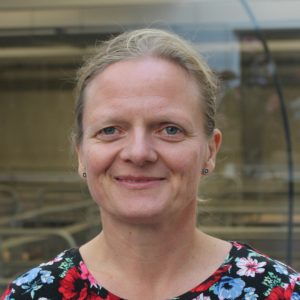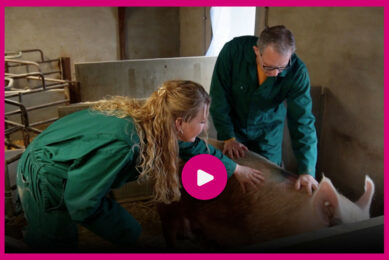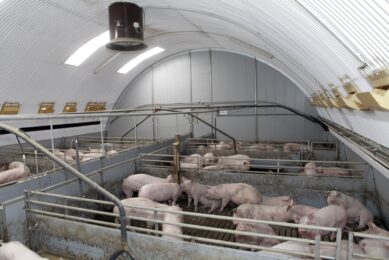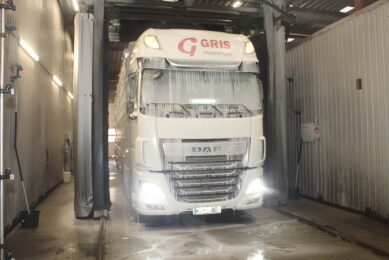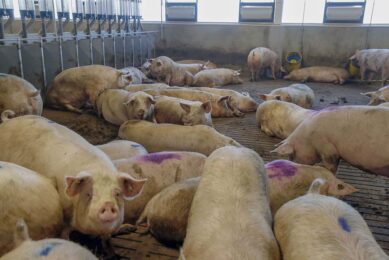Loose pig housing at lactation and low emissions? It is possible
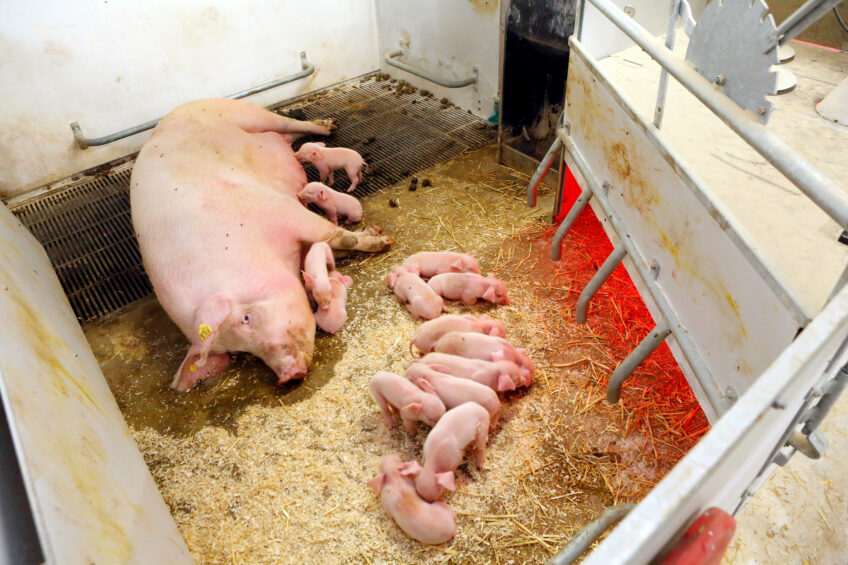
Producers all over the planet aim for high pig welfare and low emissions. However, as raised in other opinions. it can be a dilemma as welfare often includes increasing space allowance. An increase in space allowance often increases the risk of emissions, writes pig housing and welfare expert Vivi Aarestrup Moustsen.
For the last 4 years, I have had the opportunity and pleasure of being part of the project ‘Systems for Sows with high Welfare and Low Emissions’ – also known as “Sowemis.” Why does that make me grateful? Because the project has shown that we gain very important applied knowledge when universities, applied research and industry collaborate and exchange experiences and results.
Choice of a pen for pig producers
For pig producers, the choices of pen, dimensions and flooring are very important as they cannot be changed once installed. In addition, it is very expensive to build full scale for loose lactation. This makes the design one of the most important decisions for farmers wanting to install farrowing pens for loose sows, but so far research regarding robust ways to reduce emissions has been limited.
For researchers, it is very expensive to get significant replicates to have the needed power for conclusions when running trials in laboratory settings. However, results from laboratory settings can support the pig producers’ decision process – and then large-scale implementation in commercial herds can support the initial results from the laboratory and thereby increasing the robustness of the advice.
Construction of pens for loose sows
That made the Sowemis-project so valuable, as relevant measures were initially measured in a laboratory settings and then later tested in commercial settings. The fact that the results from the laboratory settings were supported by the results obtained in commercial settings makes trials from laboratory settings, where the conditions were controlled, very valuable for pig producers and their advisors when deciding for construction of pens for loose sows.
The Sowemis project ends in summer 2024. Preliminary results are both very convincing as well as promising. When the slurry surface and the slurry volume is reduced by using funnel shaped slurry pits with bi-weekly removal of manure, ammonia emissions were reduced by 40-80%, methane emissions by 30-70% and odour emissions by 50-70%. And as the project included both controlled laboratory settings and on-farm trials all supporting the findings, there is reason to expect the results to be of a generic character.
High welfare, low emissions
As the title of the project refers to, the project focused on ensuring both high welfare opportunities for the sows and low emissions. The focus has been on systems and pens for loose lactating sows. A housing system which is expected to raise significantly in propagation in the future – if it is possible to accommodate high welfare, low emissions and farm economy.
Research activities in the project included 4 work packages:
- WP1: Development of low emission slurry channels using full scale flux chambers;
- WP2: Implementation of pit ventilation in low emission slurry channels using experimental pens with sows and their litters;
- WP3: Functionable partly solid flooring; and
- WP4: Documentation of low emission slurry channels in a commercial herd.
WP1: Low emission slurry chambers
The full scale flux chambers allowed scientists at Aarhus University* to control air flow, temperature, level of pit ventilation, fouling on the solid floor, the level and surface of slurry in the slurry channels and fouling on the sides of the slurry channels.
For the different combinations, the level of ammonia, methane and odour emissions were measured. The ammonia emissions increased when the surface area increased and with fouling on the solid floor as well as fouling on the sides of the slurry channels. The results led to construction of funnel-shaped slurry pits which reduced the surface area.
WP2: Pit ventilation
In WP2, Aarhus University investigated the efficiency of varying levels (0-100%) of pit ventilation at:
- maximum ventilation;
- at 50% of maximum ventilation; and
- at 10% of maximum ventilation.
The collection efficiency of emissions was increased significantly up to 30-50% pit ventilation whereafter only marginal improvements were registered. The results led to use of 30% pit ventilation in the data collection when testing in farrowing pens with temporary confinement and sows and piglets at the Research Centre Foulum (Aarhus University).
The experimental pens measured 2.4×3 m with 2.4×1.4 m being solid equal to 47% of the floor being solid. During the trial run, 8 batches (32 sows) farrowed and weaned in the section with the solid floor being clean and dry the vast proportion of the time. The results from the test largely confirmed the findings from the measurements in the flux chamber.
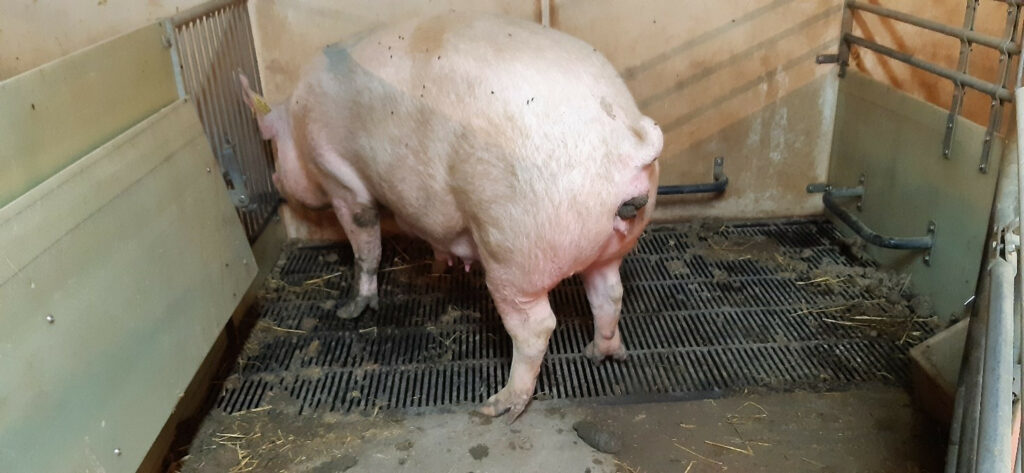
WP3: Functionable solid flooring
SEGES Innovation, in collaboration with the Skiold Group, carried out work package 3 in a commercial pig unit which implemented pens for loose farrowing sows in 2011 and later changed to temporary confinement to reduce piglet mortality. The pens measured 2.1×3.0 m with 1.2 m being slatted and the remaining 1.8 m being solid.
The first phase of work package 3 included a screening of the impact of 11 interventions. These aimed to either increasing the sows’ use of the solid area for lying expecting to lead to an increased use of the slatted area for dunging or increasing the use of the slatted area for dunging expecting to lead to an increased use of the solid area for lying. Unfortunately, none of the interventions led to satisfactory levels of hygiene on the solid floor. It is possible that the dimensions of the slatted area in the pens used were insufficient for Danish cross-bred sows to be dunging on the slatted area most of the time.
Moving feed troughs from solid floor to slatted floor
In continuation of the screening, the most promising intervention was tested in larger scale in the same herd. The tested intervention was moving the feed troughs from the solid floor to the slatted floor and installing a vertical solid plate which should influence the loose sow’s position when dunging as it directed the sows’ orientation to be standing more parallel with the back side of the pen. The results showed that the hygiene on the solid floor was improved when the feed trough was placed on the slatted floor as opposed to the solid floor. The level of hygiene was best in the beginning of lactation. If choosing partly solid floors, a daily routine of keeping the solid floor clean and dry might be needed, which adds a cost to this housing system.
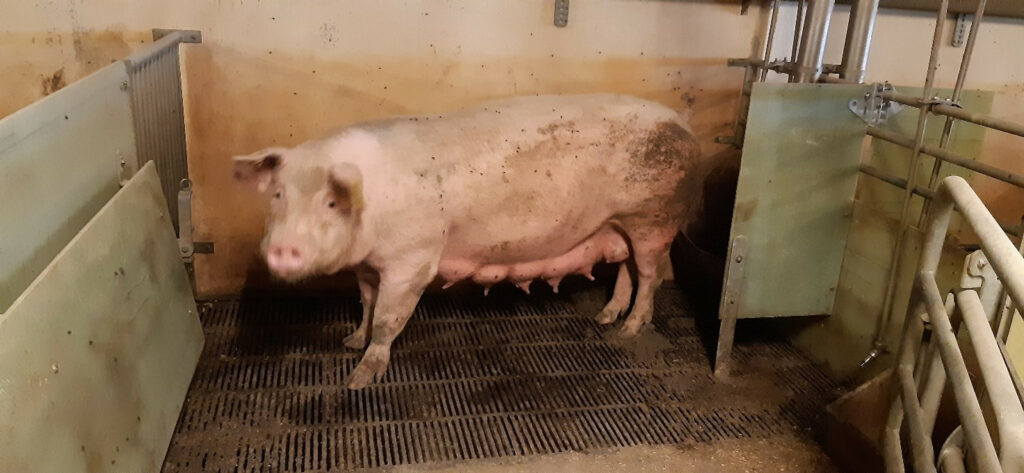
WP4: Commercial trial
Work package 4 was conducted in a commercial herd with temporary confinement pens with fully slatted flooring. The plan was to conduct this work in a commercial herd with temporary confinement and partly solid flooring. However, as the work package included installation of a slurry system it required collaboration with a pig producer ready to build for loose lactation.
At the time of the planning of work package 4, no one was building temporary confinement pens with partly solid flooring, so it was decided to conduct the trial in a herd that installed pens with fully slatted flooring.
Emissions were compared between a section with funnel shaped slurry pits and a section with a traditional flat bottom slurry pit with emptying by vacuum flushing. The results clearly indicate lower emissions when using funnel shaped pits compared to a conventional slurry system.
For a demonstration of the slurry systems, check the video and choose English subtitles.
For more information, contact the author – for details, click the author profile. Alternatively, please contact Michael Jørgen Hansen at Aarhus University (michaelj.hansen@bce.au.dk) or Stine Grønborg at SEGES Innovation (segg@seges.dk).
* Apart from senior researcher Michael Jørgen Hansen, the team at Aarhus University consisted of senior advisor Lise Bonne Guldberg and PhD-student Pablo García Perez.


